Key takeaways:
- Sensory perceptions such as aroma, texture, and color significantly influence our enjoyment and memories associated with food, especially cheese.
- Pairing cheese with complementary foods and balancing flavors, such as sweetness, acidity, and texture, enhances the overall tasting experience.
- The ambiance, temperature, and storytelling during cheese tastings elevate enjoyment, transforming each tasting into a memorable culinary journey.
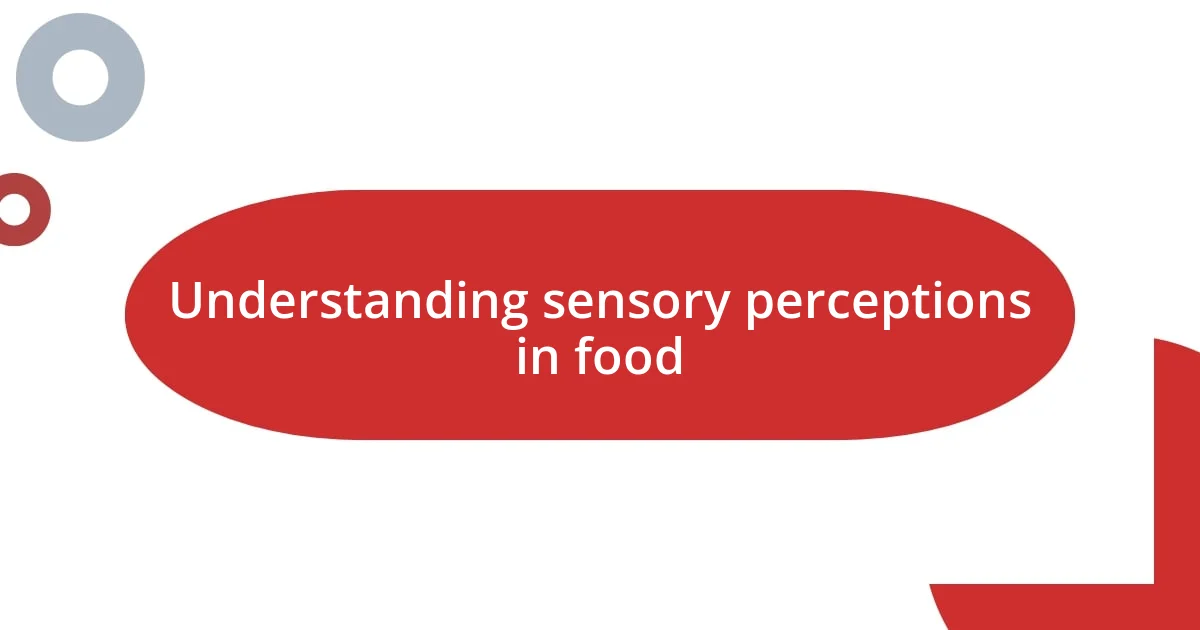
Understanding sensory perceptions in food
Understanding how we perceive food through our senses is fascinating. Our taste buds are just the beginning; the aroma of a perfectly aged cheese can transport me back to my childhood, where every visit to the local market felt like a treasure hunt. Isn’t it incredible how a whiff of something familiar can unlock such vivid memories?
Texture is another key player in our food experience. I remember biting into a fresh baguette, its crusty exterior giving way to a soft, warm interior—each bite felt like a small celebration. Have you ever noticed how certain textures evoke emotions? Think about the comfort of a creamy macaroni and cheese versus the refreshing crunch of a crisp salad. These sensations shape our overall enjoyment and satisfaction.
Color also plays a critical role in how we perceive food. A vibrant cheese platter, with its rich yellows, whites, and reds, makes for an inviting presentation. I’ve often found myself drawn to dishes that are aesthetically appealing—it’s as if my eyes are tasting before my palate ever gets the chance. Don’t you find that your mood shifts with the colors present in your meal?
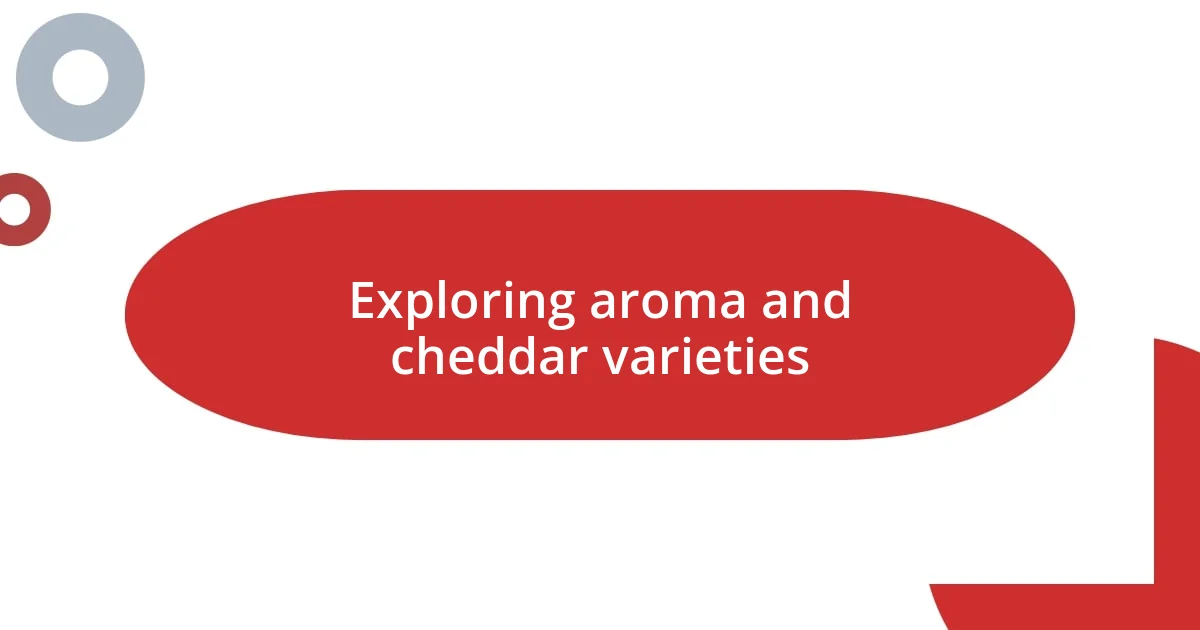
Exploring aroma and cheddar varieties
When it comes to cheese, the aroma can truly set the stage for an unforgettable experience. For instance, the pungent scent of a mature cheddar can remind me of gathering around a festive table, sharing stories and laughter. It’s that deep, nutty fragrance that tells me I’m about to indulge in something special. In contrast, young cheddar has a milder aroma, which evokes a sense of comfort reminiscent of simple family dinners. Can you recall how different cheeses can instantly alter the mood of a gathering just by their scents alone?
Exploring the varieties of cheddar further enhances this sensory journey. There’s the sharpness of an aged cheddar that tingles on the tongue, sending waves of flavor that linger long after the last bite. I remember indulging in a sharp cheddar during a cozy evening with friends, and its bold flavor sparked lively discussion about our favorite cheese pairings. By comparison, a mild cheddar offers a softer experience, almost like a gentle hug. Have you ever found that different occasions call for different types of cheddar?
As we dive deeper into the world of cheddar, it’s evident that the aroma and flavor profiles vary widely, shaping how we enjoy it. A visually appealing cheese board featuring different cheddar varieties not only pleases the eye but also tantalizes the nose, with each type bringing its unique bouquet to the mix. Such a collection offers a sensory feast, inviting exploration.
| Cheddar Variety | Aroma Profile |
|---|---|
| Mild Cheddar | Light, creamy, and buttery |
| Sharp Cheddar | Bold, tangy, and nutty |
| Aged Cheddar | Deep, robust, and complex |
| White Cheddar | Subtle, earthy, and crumbly |
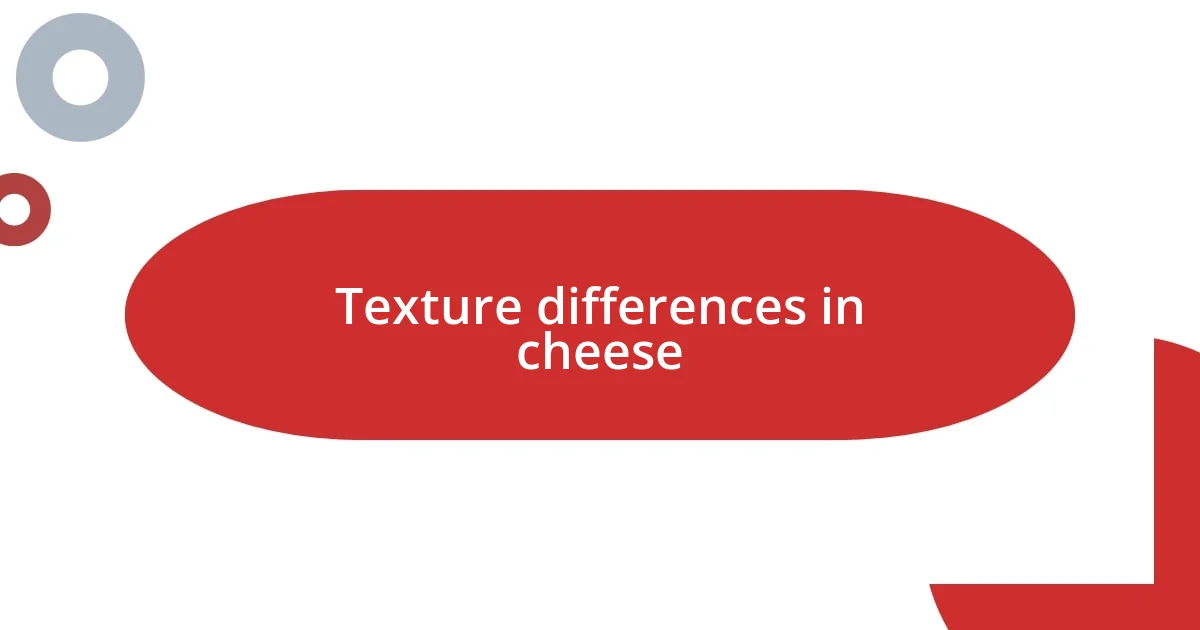
Texture differences in cheese
It’s fascinating how the texture of cheese can significantly alter our eating experience. I still vividly remember trying my first Brie, its soft, almost velvety rind giving way to a creamy heart that melted on my tongue. The contrast between the smooth exterior and the rich, buttery interior was a delightful surprise. I can’t help but smile recalling how I paired it with a crusty baguette, each bite turning into a beautiful dance of textures.
Textural differences in cheese can be categorized into a few key types:
- Creamy: Cheeses like Brie and Camembert, which glide effortlessly across the palate, creating a luxurious mouthfeel.
- Crumbly: Cheddar and Feta varieties that break apart easily, adding a delightful contrast when sprinkled over salads or incorporated into dishes.
- Firm: Parmesan and Gouda, which possess a satisfying chewiness that enhances their flavor profile, making them perfect for grating.
- Aged: Cheeses like Pecorino, with their grainy texture that becomes more pronounced over time, offering a rich, complex experience that’s both hearty and satisfying.
Each texture holds its own charm, and I often find myself reflecting on how they can evoke different emotions. For example, the richness of a creamy cheese always brings warmth and comfort, while a firm cheese can provide a sense of sturdiness and strength—perfect for a celebratory cheese board with friends. Have you ever thought about how different textures in cheese can really shift your mood and enhance your overall dining experience?
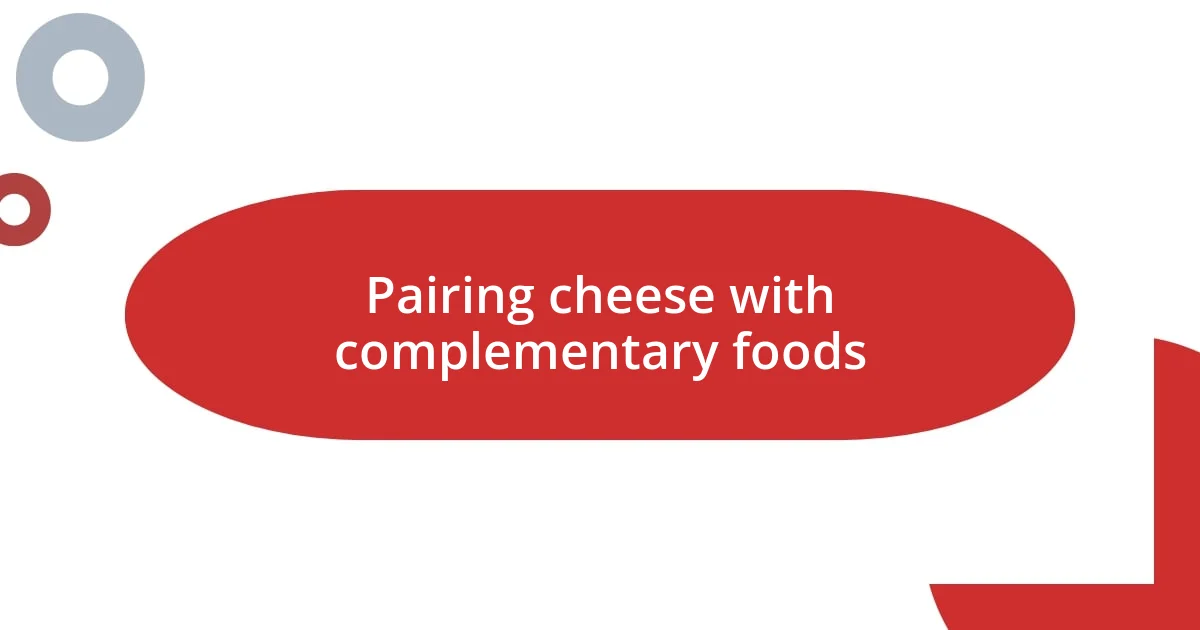
Pairing cheese with complementary foods
The beauty of pairing cheese with complementary foods lies in how the flavors meld and elevate one another. I remember hosting a small gathering where I served a sharp cheddar with sweet, ripe figs. The sweet, chewy figs contrasted beautifully with the cheddar’s bold sharpness, creating an exquisite harmony on the palate. Have you ever experienced that moment when two flavors just click, transforming an ordinary cheese platter into a memorable feast?
Another delightful combination I cherish is creamy goat cheese drizzled with honey and served alongside a handful of almonds. The smooth and slightly tangy nature of the goat cheese meets the sweet, floral notes of honey, while the almonds add a satisfying crunch. It’s a simple yet sophisticated pairing that never fails to impress my guests. How do you think these textural contrasts can enhance our overall enjoyment of cheese?
When I create a cheese board, I always consider the diversity of flavors and textures. For instance, a blue cheese alongside a slice of pear creates a wonderful interplay between the cheese’s pungency and the complexity of the pear’s sweetness. This mingling of bold and subtle flavors sparks conversation and exploration among my friends, as they dive into the different dimensions of each pairing. Isn’t it fascinating how perfectly paired foods can lead to such delightful discoveries?
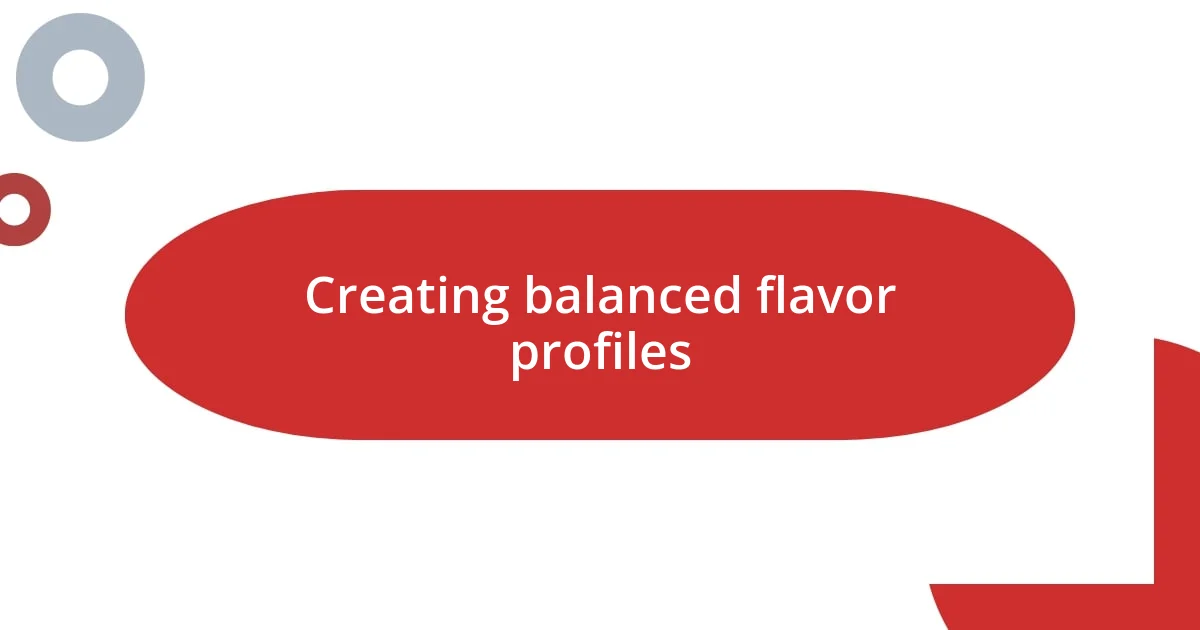
Creating balanced flavor profiles
Creating balanced flavor profiles in cheese and food is an art that can truly transform an eating experience. One time, I decided to experiment with a smoky Gouda paired with zesty pickled jalapeños. The creamy, mellow notes of the cheese beautifully tempered the heat of the peppers, creating a dance of flavors that lingered delightfully on the palate. Have you ever felt that thrilling spark when unexpected flavors come together?
I often think about the role of acidity in building balance. For instance, I recall a delightful evening where I served a tangy blue cheese with a splash of balsamic reduction drizzled over roasted Brussels sprouts. The acidity cut through the richness of the blue cheese, creating a taste balance that was both refreshing and satisfying. Isn’t it interesting how a well-placed sour element can elevate the entire flavor profile, drawing out the nuances we often overlook?
It’s this attention to detail that makes me excited about flavor profiles. Recently, I paired an aged cheddar with a homemade apple chutney. Each bite blended the sharp, crumbly cheese with the sweet, spiced fruitiness of the chutney, creating a symphony of tastes that made my heart sing. When I think of these pairings, I can’t help but wonder: how many culinary adventures are waiting for us in our own kitchens, just around the corner?
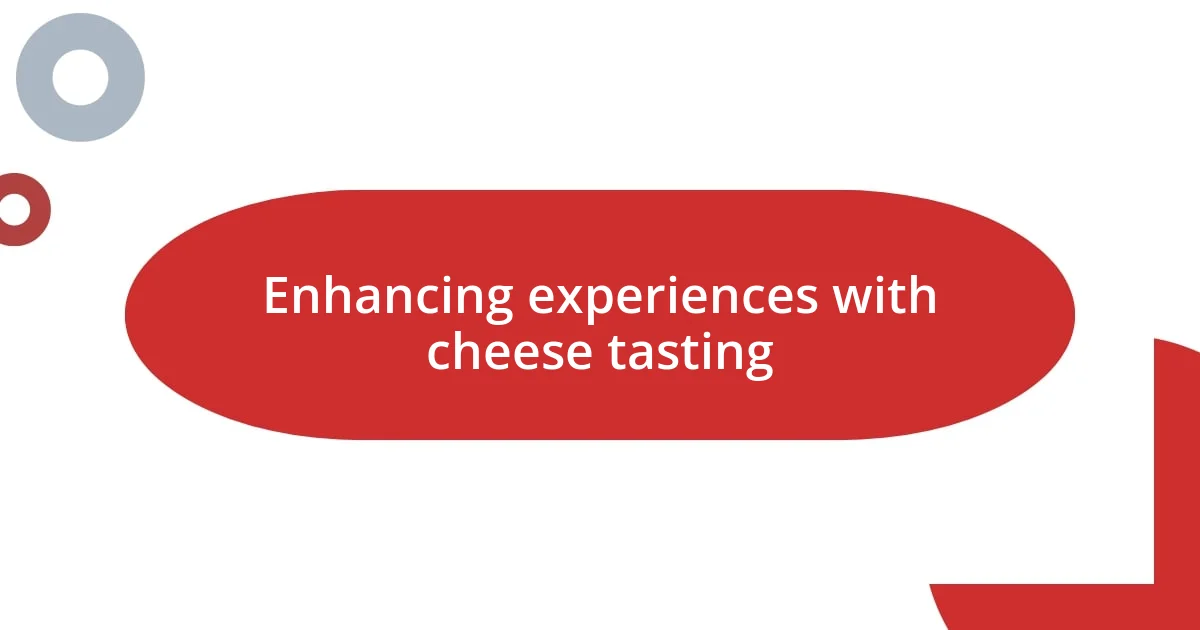
Enhancing experiences with cheese tasting
I’ve found that the ambiance during a cheese tasting can profoundly influence the experience. One evening, as I settled down with a few friends for a cheese-led soirée, we lit candles and played some soft music. Suddenly, the sharp flavors of a blue cheese paired with a fruity red wine completely transformed – it felt like we were embracing the very essence of indulgence. Doesn’t the right atmosphere amplify your enjoyment, making each bite feel like a moment to savor?
I also love experimenting with temperature during tastings. I vividly recall serving a rich brie at room temperature alongside freshly baked baguette slices. The creamy texture of the warmed brie oozing over the crusty bread created a melt-in-your-mouth sensation that was heavenly. When was the last time you thought about how the warmth of food interacts with its texture and flavor?
Finally, I believe storytelling plays a crucial role in enhancing cheese experiences. Sharing the unique origins and stories behind each cheese not only brings the flavors to life but also fosters connection among tasters. I remember discussing the tradition behind an aged cheddar from England, and suddenly, each bite tasted richer and more meaningful. Isn’t it amazing how a little context can elevate our enjoyment, turning a simple cheese tasting into a delightful culinary journey?















